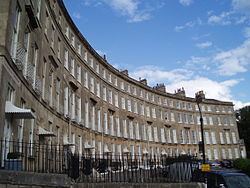Built c.1815-30 Reference no. 442404 | Designated 12 June 1950 Opened 1830 Architect John Pinch the elder | |
 | ||
Location Bath, Somerset, England Similar Pulteney Bridge, Victoria Bridge - Bath, Bishopstrow House, Norfolk Crescent - Bath, All Saints' Church - Weston | ||
Cavendish Crescent in Bath, Somerset, is a Georgian crescent built in the early 19th century to a design by the architect John Pinch the elder. At 11 houses, it is the shortest of the seven Georgian crescents in Bath. It also has one of the plainest facades, with no central feature, the only decoration being the consoles over the central first floor window of each house.
Contents
Map of Cavendish Cres, Bath BA1 2UG, UK
History
Cavendish crescent was undertaken by William Broom, a builder by trade. Broom leased the land on which the crescent is built and then engaged Pinch to design the facade. However all did not go according to Broom's plans and he went bankrupt in 1825. The crescent was finished some 5 years later.
Notable residents
Sir William Holburne lived at No. 10 between 1829 and 1874. The house was home to his art collection, which was later formed into the Holburne Museum of Art, at the end of Great Pulteney Street.
